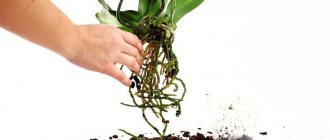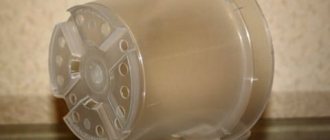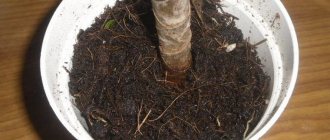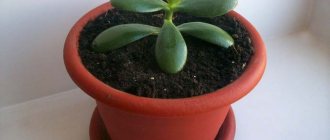In this article we will talk about how to properly replant an indoor flower.
Were you given indoor flowers or did you buy them yourself to please yourself? How lovely. Every day the flower will delight the eyes with its appearance, and also bring benefits by purifying the air. But to enjoy its appearance, you need to properly care for it, water it and, if necessary, replant it.
Spring is the best time to replant indoor flowers. But there are some reasons when a transplant is necessary, and it doesn’t matter what time of year it is outside.
What to do if there is a need to replant a flower not in the spring?
If you understand that without replanting the plant will die (for example, because the roots are rotting or pests have appeared in the soil that you cannot control with the help of special chemicals), the plant can be replanted at another time of the year. In the spring, as stated, plants tolerate transplantation best and, moreover, need it at this time. However, in summer, autumn, and winter they are able to take root in a new flowerpot. When transplanting in winter, the risk of losing the plant is maximum; flowers transplanted in summer and autumn usually survive.
How often should a plant be replanted into another pot?
It is not worth replanting the plant into another pot more than twice a year. Even this frequency is considered frequent, so the flower is replanted more often than once a year only in cases of expressed need. Otherwise, everything depends on the type and age of the plant. Young plants are usually transplanted into a new pot annually, adults - once every 3 years, sometimes even less often.
Does the size of the pot matter?
Both the size and shape of the plant pot are important. The new pot into which the flower is going to be transplanted should be approximately 2 cm larger in diameter and higher than the one from which the plant is transplanted. In this case, he will be comfortable in his new place of residence for a long time.
The preferred form depends on the type of plant and the location of its root system. Succulents and cacti need a wide and shallow pot, flowers with a developed root system need a deeper one.
Regardless of the type of plant, the pot should be narrower at the bottom than at the top, otherwise it will be problematic to transplant the plant from it into another pot.
How to choose the right soil and container?
The composition and characteristics of the soil are selected individually, since each type and variety of flowers has its own requirements for the substrate. You can purchase a ready-made substrate in the store or prepare it yourself:
- Palm trees love loose, breathable soil. A mixture of leaf and turf soil, peat and perlite in a ratio of 2:2:1:1 is suitable for them. For large adult specimens, the percentage of soil is increased, peat and perlite are added in smaller quantities.
- Ferns require loose, fertile soil. They grow well in a mixture of universal soil, peat, humus and vermiculite (2:1:1:1).
- Monstera and philodendron develop well in a mixture of equal parts of leaf, turf soil and peat. You can loosen it with the addition of sphagnum moss or charcoal.
- For cacti and succulents, soil fertility is not as important as its breathability. Coarse river sand and vermiculite (2:1:1) are added to the universal soil.
- The Bromeliad family does well in a mix of half universal soil and half orchid substrate.
Leaf and turf soil is disinfected before use. To do this, it is poured onto a metal sheet and heated in the oven.
The container is also selected according to the characteristics of each type:
- Wide, shallow flowerpots made of clay and plastic are more suitable for cacti and succulents;
- ferns and bromeliads, which reproduce by suckers and rosettes, require wide pots;
- palm trees with deep, powerful roots need a deep container.
The basic universal rule is to increase the diameter and depth of the new pot by 2-3 cm. A plant transplanted into a pot that is too large will devote all its energy to developing the root system. The ground part will slow down in development. In addition, the large size of the pot provokes acidification of the soil.
Attention! A new clay and ceramic pot is pre-washed and placed in water to saturate the porous material with water. The old pot is washed and the inner surface is cleaned of salt accumulations.
Do I need to prepare the pot?
Any pot must be thoroughly washed and dried. It is especially important to thoroughly wet and dry porous clay pots.
Also, it would not hurt to treat the pot with a solution of potassium permanganate to protect the plant from possible diseases and pests. It is especially important not to neglect this procedure if another plant was already growing in the pot before.
If the pot is new, it may not have drainage holes. This drawback should be eliminated yourself by screwing the holes with a drill or an ordinary drill or awl. You can punch holes with a nail, but in this case there is a danger that the plastic will crack and the pot will split.
Possible mistakes
To ensure a high-quality transplant, you should pay attention to common mistakes. These include:
- incorrect time for the procedure;
- using a much larger pot;
- incorrectly selected soil mixture;
- a small number of drainage holes at the bottom of the container and lack of drainage;
- deepening the root collar into the soil;
- failure to comply with instructions and rules for replanting indoor plants.
What else, besides a new pot, is needed to replant a plant?
To transplant a plant into another pot, you will definitely need drainage (it can be replaced by shards, polystyrene foam) and soil. Without drainage, the roots of the flower will quickly rot and it will die. If the old soil is not replaced with new soil, replanting loses its meaning altogether. The composition of the soil must correspond to the needs of the plant (violets need one, cacti need a completely different one).
In addition, tools (knife, pruning shears) may be required. When replanting cacti or poisonous plants, be sure to protect your hands with gloves. However, they will not interfere in any case.
Preparatory work
Prepare everything you need in advance. They purchase soil for each type of indoor flowers and disinfect it. They stock up on drainage - expanded clay, pebbles, coarse sand, shards, charcoal, etc. are suitable for this purpose. Select suitable flower pots. In cases where the plants have grown significantly, pots are selected larger than the previous ones. If you plan to remove some of the damaged roots, take a container smaller than the previous one. All pots are washed thoroughly. The plants are watered the day before the event. Prepare the workplace: cover the table with film or newspapers.
Do I need to water the plant when transplanting?
The issue of watering flowers before and after transplantation is the most controversial among amateur flower growers. Some believe that the plant needs to be well watered just before replanting, and then not watered for a long time, others believe that watering is needed immediately after replanting, but the plant should not be watered before replanting. The optimal solution would be the following:
- Water the plant a few days before transplanting so that the soil is not too dry at the time of transplanting. If you water the flower immediately before transplanting, the heavy soil will tear its roots. If the soil is dry, then shaking it off the roots will almost inevitably damage them too.
- Replant the plant in slightly moist soil so that the roots can immediately receive nutrition from the soil.
- Start watering the transplanted flower a few days after transplantation, and watering should not be abundant. The fact is that young and injured roots quickly rot if over-moistened. Moreover, the more the plant is afraid of excessive moisture, the later it should be watered after transplantation. Start watering moisture-loving flowers in a day or two, otherwise they will begin to fade. Start watering cacti only after a week. On average, watering is resumed on the third day after transplantation.
To avoid making mistakes, check when it is advisable to start watering the plant you are replanting. This circumstance depends mainly on the type of indoor flower and on the state of its root system. It is logical that if you are replanting a flower because its roots have begun to rot, excessive moisture after replanting will be completely detrimental to it.
Ceramics or plastic
Proponents of clay pots focus on the porosity of the material. This allows air to move freely, excess moisture evaporates, and harmful salts do not settle into the soil. Such pots have a very impressive mass, which prevents them from accidentally falling from a draft or a naughty animal. Ceramic containers are very durable.
Plastic pots are much cheaper than ceramic ones. They are easy to wash and clean, they are not heavy. And the varied color range of plastic products allows you to match them to any interior and create original color compositions.
When choosing a material, you should remember that the porous structure of clay pots cools the surface due to the evaporation of moisture. Therefore, for heat-loving plants, such containers will need to be additionally insulated. The disadvantages of ceramic pots include the fact that hard water causes unsightly salt stains to appear on the clay.
How to get rid of stains on ceramic surfaces:
- wipe the container with potato peels, then rinse thoroughly and let dry naturally;
- stir a little detergent in the water, lower the pot into the solution for a quarter of an hour. Go over the entire surface with a stiff brush. Dissolve 1 part bleach in 10 parts water and rinse the pot with it. Rinse thoroughly with water and dry.
Flower pots are also made from ceramics. This product serves only as decoration; planting plants in it is prohibited. Because a completely glazed surface does not allow the plant to breathe. Also, the pots do not have drainage holes.
Plastic pots:
- retain moisture for a long time - it is necessary to control the frequency of watering and correctly calculate the amount of fertilizer. In such products, suppuration of the root system may begin;
- plants in plastic containers should not be left in the bright rays of the sun - overheating of your green pet is possible;
- Light-colored plastic pots are preferable because they repel excess heat.
Do I need to fertilize flowers when transplanting?
You may find fertilizers in the store that say they help the growth of the root system when replanting plants. But this does not mean that they can feed the flower immediately after transplantation. When transplanting flowers, you cannot fertilize them! After this point, at least two weeks, and preferably even three, should pass before the first portion of fertilizer is introduced. After this, in spring and summer, indoor plants are fertilized 2 times a month, during the dormant period - once a month or even less often.
Pay attention to illnesses
Before you start replanting a plant, you need to carefully examine it and determine whether it has diseases or pests. This determines whether the pot can be used for other plants, as well as what method of replanting will be chosen later.
Plant growers often attribute the unsatisfactory condition of indoor plants to other factors: cold winter, errors in care, poor seedlings. Of course, such assumptions may turn out to be true. But when working with potentially diseased plants, it is better not to take risks, since carelessness can lead to infection of other greenery in the house.











